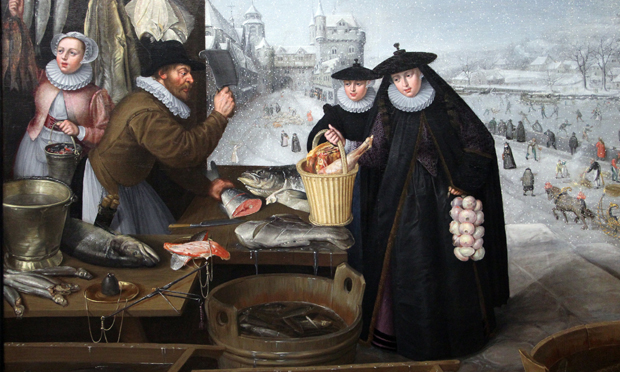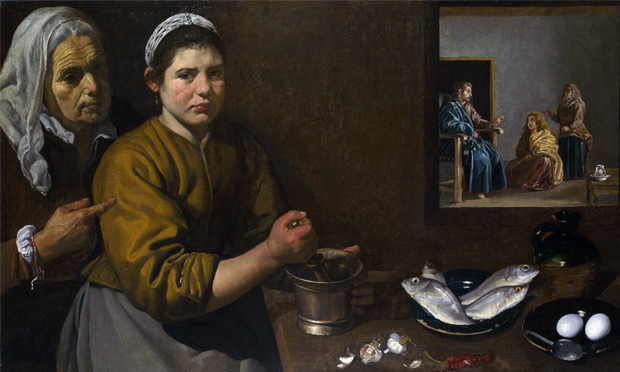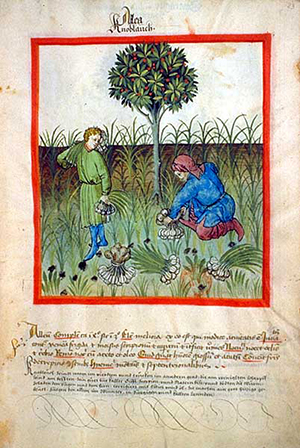Guy Fawkes, garlic and and the Great Pyramids: notes on November in food history

“Back then eating garlic had all the thrills of transgression and identifying with the Other’: Lucas van Valckenborch’s Winter (c. 1595). Image: Wikimedia Commons
When, on 31 October, misanthropic elderly Hackney citizens switch off all the lights and cower under the kitchen table, you know that Halloween is upon us, as voracious, over-indulged feral children rampage among our tranquil £1 million hovels demanding ‘Trick or treat?’, and greengrocers crumble under the weight of overpriced, bloated pumpkins.
This recent alien craze gets conflated with Bonfire Night on 5 November, so let’s blame Guido (pronounced Ghee-dough: Spanish, not Italian), for providing a link with supposedly ancient bonfire rituals.
However did a nice Yorkshire lad like our Guy get mixed up with garlic-eating Papists and go gadding off abroad to join Spaniards fighting our noble allies in the Low Countries? It’s true his grandparents were Roman Catholics, and his widowed mother married one, but still…

Guy Fawkes feels the heat at Lewes fireworks. Photograph © Andrew Dunn
Years later it all came to a head in the Gunpowder Plot, when Guy Fawkes and a group of like-minded friends plotted to blow up King James I in the Houses of Parliament on 5 November 1605, regardless of collateral damage (the massive explosion of 36 barrels of gunpowder hidden in a cellar beneath the House of Lords would have destroyed homes and killed hundreds of citizens).
The plot was discovered and the conspirators tortured and hanged; the brutality of this is horrible to contemplate, but it is a reminder of the cruelty and inhumanity of religious intolerance then and now.
Protestants had been given the same treatment in Europe. The inevitable political repercussions of the Gunpowder Plot ruined the hopes of British Catholics for a relaxation of persecution, and caused much diplomatic mayhem in Europe.
There’s an ambiguity in our celebration of this non-event with bonfires and fireworks, (which James I ordered us to do by way of thanks) though today on the whole we avoid burning effigies of people we dislike. But November is when the matches come out.
During World War II, us village kids in Cawood, not far from York, painted a Hitler moustache on our ‘Guy’, while in 2017 the citizens of Lewes deconstructed David Cameron in Union Jack boxer shorts with a pig’s head in his lap, and incinerated a sheepish Sepp Blatter, while Lady Thatcher did not escape a singeing.
Thus we commemorate the success of our security forces in foiling a dastardly plot, by encouraging arson, character assassination and civil unrest. And by eating.
Typical Bonfire Night food used to be simple – potatoes roasted in the embers, maybe a few sausages (wartime sausages consisted mainly of stale breadcrumbs and stale fat) and home-made gingerbread.
Maybe it was the austerity of rationing in those days, or the deliberately fostered distrust of Europeans, but we all knew that Foreigners were Papists and ate horrible food swimming in olive oil and reeking of garlic.
Olive oil was what you went to the chemists for when you had earache, and garlic was the ruination of good plain food and made your breath smell horrid. No wonder many of my generation have been overdosing on both substances ever since.
Back then, eating garlic had all the thrills of transgression and identifying with the Other, and it tasted wonderful. The Puritanical rejection of it was flying in the face of history – for the allium family, which includes leeks, chives, and onions, had been used in Britain ever since its introduction by the Romans, along with cabbages and many herbs, and it was only recently that Victorian respectability and narrow-minded Middle Class chauvinism drove garlic from our kitchens.
As our versatile legionary swung up North with his usual heavy load, he was chuckling to himself at the thought of the illicit bag of black peppercorns, worth their weight in gold but light as feathers, hidden among his forced-march provisions of several heads of garlic.
Legionaries were at the cutting edge of the Roman Empire, expanding and defending it, and they needed to be as fit as fleas. Conditions were arduous but the pay was good, and the perks of a comfortable retirement a big incentive.
Marching was as vital as fighting, so staggering up Stamford Hill with a hangover was not encouraged, but could be mitigated with a soup of much garlic, simmered in oil then stewed with a bunch of sage leaves, and taken with an egg or two sloshed over hardtack.
Warriors and prize-fighters rubbed themselves with crushed raw garlic, and munched on several cloves before an encounter. Modern medical opinion endorses this, for garlic has healing and antibacterial properties, and could help staunch wounds and mend sores, as well as stimulate bellicose zeal.

Crushing: Cristo en casa de Marta y María, by Diego Velázquez. Photograph: Wikimedia Commons
It used to be known as the ‘theriac of the poor’, being a cheap substitute for an eye-wateringly expensive mixture of herbs, spices and strange ingredients that was prescribed by physicians as a universal cure-all throughout the Middle Ages and beyond.
Our legionary knew better, chomping on his garlic and savouring the aromatic whiff of peppercorns. Many of us, without rigorous science-based evidence, are convinced that chewing 3 or 4 cloves of raw garlic every few hours can cure or ward off a bad cold.
Peppercorns, a hugely expensive imported spice, were a nice little earner on the Black Market in Vindolanda; even an auxiliary on low pay still managed to fork out a large proportion of his salary for a handful, perhaps to remind him of duties in Egypt, where pepper and garlic perfumed the street food, as they still do today.
When Herodotus the great Greek historian went to Egypt as a tourist he got what was coming to him when he asked his illiterate guide about an inscription on the Great Pyramid at Giza.

Harvesting garlic featured heavily in medieval health handbook, Tacuinum Sanitatis. Photograph: Wikimedia Commons
The guide, as quick off the mark as a paid-up member of Unite, said it was all about the workers’ rights – they needed supplies of radishes, onions and leeks as they laboured on the construction of the pharaoh’s tomb.
Herodotus swallowed this hook line and sinker, and has been quoted ever since as evidence of garlic eating by the lower orders. But recent archaeological discoveries not far from the Great Pyramids tell us that far from being underfed slaves, the workers on the pyramids were Egyptian citizens enjoying a nice jobsworth, with free housing and a nourishing diet.
Like the later Roman legionaries they had to be strong and fit to do their job (preparing and heaving massive blocks of stone with no mechanical help apart from pulleys and ropes) so were fed lots of meat, with garlic and onions as a relish.
The pepper and garlic of Vindolanda are present in just about every style of cooking flourishing in Hackney today, with chilli peppers (capsicum annuum) giving a kick from capsaicin, sometimes replacing the bite and flavour of black peppercorns (piper nigrum).
Salt, peppercorns and garlic, pounded with a pestle and mortar, and softened with a little olive oil, are the start of many recipes from guacamole to aioli.
This basic mixture, with some chopped parsley and grated lemon zest, can be worked under the skin of a chicken before roasting, or daubed on chops before grilling, or stirred into soup or gravy just before serving, or part of a marinade, or used to anoint roast vegetables. Thus can we toil like Roman soldiers and feast like the Pharaoh’s workmen.
But it gets even better, for the vast flavour spectrum of garlic, from harsh and raw, to simmered in olive oil to a pale gold, giving a gentle sweetness to pasta sauces, or fried to a deep caramelised brown, and added to spiced dishes, or cooked in its skin until soft and squishy along with a roast, a sort of flavour exchange as the gravy takes on the garlic and the garlic wallows in the meat juices. Long after the bonfires have died down and the pumpkins rotted away, we can enjoy November’s bounty with our knives and Fawkes.
